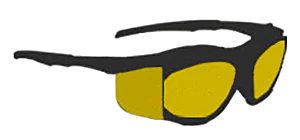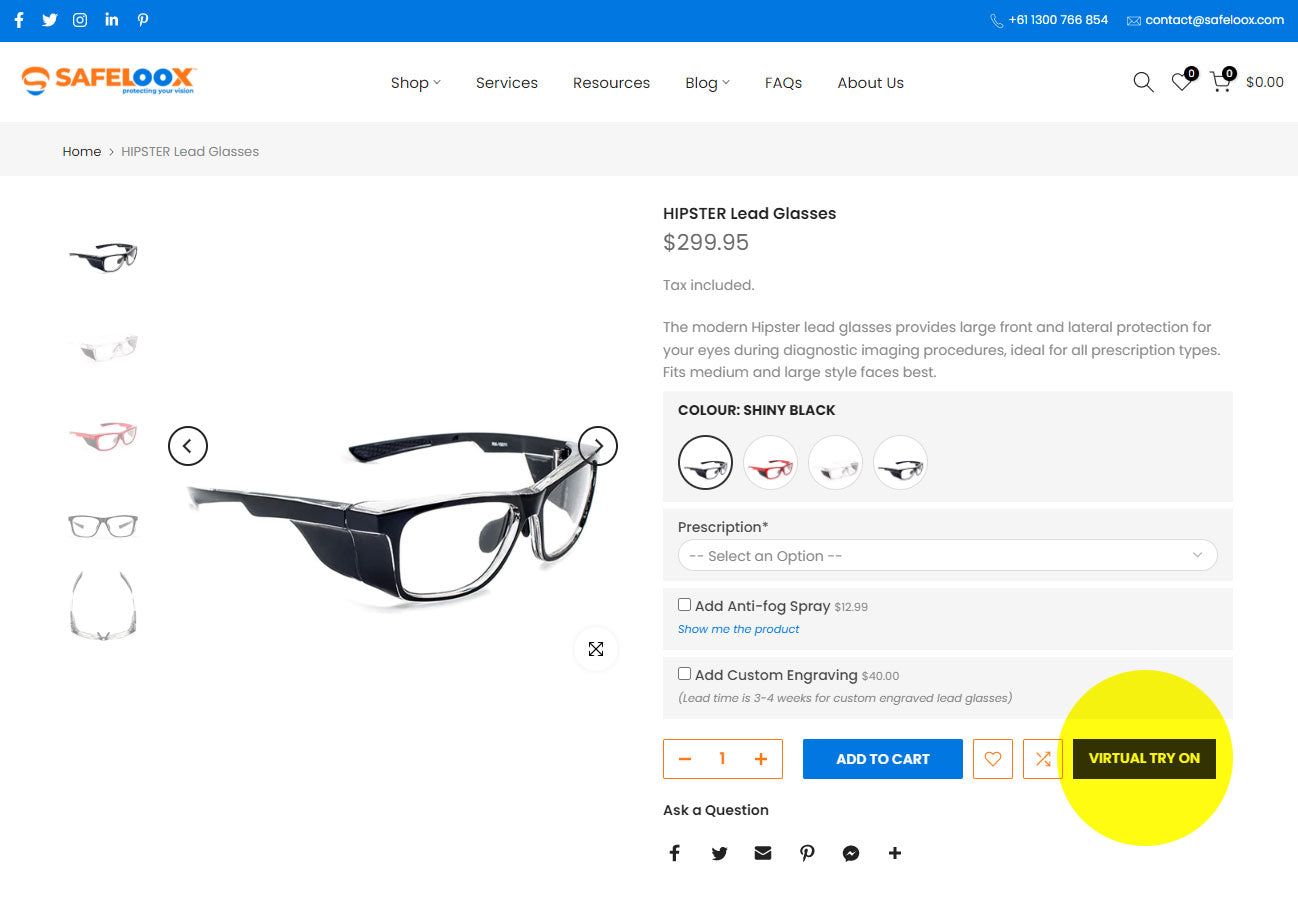Any healthcare professional working with radiation daily knows that protecting your body and eyes against x-ray radiation is crucial to avoid or minimise potential harm to long-term health and well-being. (1)
It is concerning that many hospitals and other medical organisations do not provide lead glasses to their medical staff despite the evidence of radiation causing harm to the body and eyes when unprotected(2). Generally, hospitals provide lead aprons to protect the body. However, lead glasses are usually not part of the compulsory radiation protection outfit. In many cases, medical staff do not wear lead glasses (because they are not provided) or just buy them individually out of their own pocket.
Your eyes are among the most sensitive areas of your body, and when you work with radiation, they also tend to be the most exposed. Wearing leaded eyewear is just as important as wearing a lead apron.
But do you know what type of radiation eyewear suits you best to ensure you get the protection you need? This article provides a guide for healthcare professionals on finding the right lead glasses that protect them against radiation and comfortably fit their faces; factors that are crucial in ensuring that your eyesight will not be permanently damaged.
If you’re looking for leaded eyewear, here’s what you should pay attention to:
1) Understand Your Radiation Protection Requirements
Finding the right lead glasses requires a good understanding of your radiation exposure which defines which model of lead glasses gives you the best protection. Therefore, the same exposure to potential radiation is crucial. If it is only straight ahead, you might be able to use different glasses than if the radiation comes from multiple angles. The best way to learn about your exposure is to speak with your supervisor or radiation safety expert, such as Medical Physicist and Radiation Safety Officer.
2) Check the Level of Radiation Protection
Lead Equivalence
The most crucial factor is to check the lead equivalency (LE) of the leaded lens of the radiation glasses, which is the protection thickness of the leaded lens. The Australian Radiation and Nuclear Protection Association (ARPANSA) have made a series of recommendations related explicitly to Radiation protection of the eyes. They recommend lead glasses with 0.75mm lead (Pb) equivalence and the use of side shields to ensure adequate protection from radiation exposure. (3)
Side Shields
Look for radiation glasses that offer lateral protection of the eyes to provide wraparound protection. The recommended LE for leaded side shields is 0.50mm Pb.

Type of frames
There are three kinds of lead glasses that provide different levels of protection.
| Wraparound Lead Glasses | Semi-Wraparound Lead Glasses | Flat Lead Glasses |
|---|---|---|
| This type offers ‘wraparound’ protection at the front and around the side of the eye. Depending on the curve of these frames, they do usually not require additional side shield protection. | This kind of frame provides front protection and some side protection (‘semi-wraparound’). It is usually recommended to add leaded side shields for additional lateral protection. | This frame is ideal for many prescription types and scripts. However, they only provide front protection. If you choose a flat leaded glasses frame, ensure they feature side shields where leaded side shields can be attached to offer wraparound protection for your eyes. |
| Provides limited choices for prescription leaded lenses due to the wraparound curve. | Suitable for most prescription leaded lenses | Ideal for all prescription leaded lenses. |
 |
 |
 |
3) Factors that influence your comfort
- Weight -
Choose a pair of lead glasses with the lowest possible weight, which may increase your comfort, especially during lengthy diagnostic imaging procedures, for example, in Catheter Laboratories. Radiation protection eyewear is naturally heavier than standard safety eyewear. The lead in the lens is the heavy part. The bigger the leaded lenses are, the heavier your lead glasses will be. The weight of lead glasses can range from 55g to about 100g.
Furthermore, prescription lead glasses can be slightly or significantly heavier than non-prescription lead glasses, depending on the person’s script. This is the case especially for bifocal and progressive lead glasses, as the lenses are laminated and thicker. The higher your prescription is, the thicker and heavier the leaded lenses will be. As every script is unique, only an estimated weight range can be given, usually between an additional weight of 5 to 20grams.
For more information, refer to the blog article "Find the right prescription lead glasses."
- Size -
Through Frame Measurements
The traditional way of determining the right size of your lead glasses is usually through the frame measurements provided by the manufacturers. They recommend on their websites what pair of lead glasses suits what type of face shape; small, medium, large, or extra large. Simply looking at the product photos using a size description can sometimes be hard to gauge. You can check if the product pages include measurements about the lead glasses frames, such as frame width, bridge size, length of temple arms, lens width and height. If that’s the case, you are most likely able to compare the frame measurements of the lead glasses with either a pair of your sunglasses or prescription glasses to gauge whether the lead glasses frame will fit your face shape.

Through Virtual Try-On
An innovative way to determine if the lead glasses will fit you is utilising the new ‘Virtual Try-On’ Technology. This virtual tool is widely in use for choosing sunglasses online. SAFELOOX now offers the Virtual Try-On technology to diagnostic imaging healthcare professionals in Australia, making it easier to select the right radiation glasses online. The Virtual Try-On allows you to ‘try on lead glasses options online and instantly see how you look with the radiation glasses from SAFELOOX. You can virtually experience the fit of lead glasses as it responds to your movements and allows you to see how the glasses look at different angles on any device in real-time. So you can purchase your lead glasses with more confidence and fidelity.
The size of your face is determined by the information you provide, such as your gender or pupillary distance (which is the distance between the centre of your pupils). Choosing your gender offers statistical accuracy. However, entering/ selecting your pupillary distance (PD) provides the most accurate fit for your face.
If you do not know your PD, you can either check with your optometrist (in case you already wear prescription glasses) or measure your PD online.
Possible Add-ons
Lead glasses are generally not the most comfortable pair to wear due to the weight of the leaded lenses. But they are necessary to protect your eyes from the harmful effects of radiation during diagnostic procedures. Different companies may offer all or a selection of the following lens coatings and other features to increase the wearer’s comfort.
- Padded nose bridge and rubberised temple arms to help increase the wearer’s comfort and reduce the impact of weight on the nose.
- Side Shields (if not already included) to provide lateral radiation protection for your eyes.
- Custom-engraving of names or phone numbers on temple arms for identification purposes
- Anti-fog coating (usually a permanent lens coating) to minimise fogging.
- Anti-reflective coating (usually a permanent lens coating) reduces glare and lens reflections.
4) Trial Options to experience fit and weight
Once you have determined which lead glasses you like best based on your research (prescription limits, weight indication, face shapes, frame measurements, possible add-ons) it’s time to confirm that the lead glasses of your choice are comfortable to wear and fit your properly. Ask companies who sell radiation protection eyewear if they offer the following trial options:
Virtual Try-On
It offers you a real-fit experience, helping you to select the right lead glasses by trying them on 'virtually', showing you how the lead glasses look and fit online. (refer to 3)
SAFELOOX has made the most popular lead glasses available to try on virtually.

Real Product Trial
helps ensure you are happy with your choice and investment. You can experience the actual weight and comfort of your lead glasses by trialling lead glasses at home or in your workplace for a period to make.
For the following three reasons, you should insist on some try on or trial:
-
The lead glasses provide maximum radiation protection for your eyes
Lead glasses that fit you properly provide higher radiation protection. Ensure the nose piece of the lead glasses fits securely and comfortably on your nose. The frame of the lead glasses should work closely to the side of your head, allowing the glasses to stay on during medical procedures.
-
The lead glasses are comfortable to wear
Manage your expectations and experience the weight of the non-prescription trial leaded glasses. Scripted lead glasses can add a little bit more weight, depending on your script.
-
Ensure you are happy with your choice & investment
Some lead glasses can be pricey, so you want to ensure you have invested in the right pair of lead glasses that you will wear to protect your eyes from radiation. If companies do not offer product trials, find out about the manufacturer’s return policy. Check if you can return your purchased lead glasses if you are unhappy with them.
5) Repair Services & Warranty
Before purchasing radiation protection eyewear, it’s worth finding out about return policies, terms of warranty, insurance options and repair services of the manufacturer or supplier. As an industry standard, most companies offer a 1-year warranty on materials and artistry. The Warranty guarantees your lead glasses be void of defects in material and craftsmanship, including the leaded lenses and the frame.
However, note that the warranty usually doesn’t cover cracked or broken leaded lenses, for example, when you drop them. Leaded lenses are very fragile and can easily break when you drop them. Check if companies offer any insurance or repair services for your lead glasses. It can be expensive to buy a new pair of radiation glasses.
Repair services include the replacement of cracked leaded lenses or prescription leaded lenses with new leaded lenses, which gives you the benefit of keeping your frame and minimising your cost as you don't need to buy complete new lead glasses.
Checklist
Follow this guide and find lead glasses that tick all the boxes.
|
For your protection |
|
| For your Comfort |
|
| Check Trial Options |
|
| Services & Support |
|
Wearing radiation glasses is a beneficial and scientifically proven process for healthcare facilities across Australia in today’s age. Proper protection can represent a significant financial investment for some employers. However, this is insignificant when compared to ensuring their staff are safe. Properly looking after personal protective equipment like lead glasses will adequately look after professionals who work amidst radiation.
SAFELOOX offers a complete line of non-prescription and prescription radiation glasses. If you have any questions about our products or radiation glasses in general, please feel free to contact us: Phone at 1300 766 854 or email at hello@safeloox.com.au
Citations:
(1) Linet MS, Kim KP, Miller DL, et al. (2010), Historical review of occupational exposures and cancer risks in medical radiation workers
(2) ICRP (2011), Statement on Tissue Reactions
(3) ARPANSA Fact Sheet, Improving Eye Safety in Image Guided Interventional Procedures (IGIP), Available online, March 2015, (26/08/2021)

